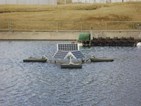SolarBee Circulation Technology Cuts Aeration Runtime

Activated sludge wastewater treatment plant cuts runtime of high-horsepower aerators from 240 to 180 horsepower.
A SolarBee mixer installed at the activated sludge wastewater treatment plant in Eden, NC has helped reduced annual electricity cost 42 percent and provided an 11-month payback. The SolarBee unit takes over some of the mixing and oxygenation previously supplied solely by high-horsepower electric aerators.
The main reactor basin where aeration is supplied for mixing required 12 20-horsepower aerators for a total of 240-hp of aeration. This amount of aeration kept total suspended solids (TSS) in the 3,000 - 4,000 mg/L range, as required to meet EPA National Pollution Discharge Elimination System (NPDES) requirements.
“We ran brush aerators constantly to try and mix it all, but they could only mix and aerate the top half,” said Melinda Ward, wastewater treatment plant superintendent. “The results were a high, wasteful level of dissolved oxygen at the top of the basin and a mass of sludge at the bottom that wasn’t impacted by the treatment process.”
Dissolved oxygen (DO) concentrations were 8-10 mg/L, much higher than needed, yet the aeration could not be turned down because it was needed to suspend the solids.
After consultation with SolarBee engineers, Ward installed one SolarBee SB 10000v18 unit and deactivated the three aerators closest to the solar-powered unit. Over time, she deactivated three additional aerators. “We could actually see the solids moving,” she said. “It’s amazing how the SolarBee mixer brings them up to the top of the basin.” An additional but welcome benefit was better sludge settling at the clarifier, leading to reduced effluent TSS.
How SolarBee mixers work
SolarBee’s patented long-distance circulation technology creates a near-laminar flow pattern that completely mixes the water column. The SolarBee unit transports about 10,000 gallons per minute of water to the surface. Approximately 3,000 gallons per minute of direct flow ascends through the intake hose; another 7,000 gallons per minute of induced flow ascends external to the hose. Water departs from the unit radially without turbulence, both above and below the distribution dish, mixing with other surface currents to redistribute water across the treatment area.
According to Ward’s electrical bills, annual electricity use declined by 1,692,000 kWh, or 42 percent. Annual electricity cost decreased by $61,101, or 31 percent, as the cost of electricity rose. The cost savings on electricity resulted in a 10.7 month pay-back period, promising long-term cost savings for the citizens of Eden.
About SolarBee
SolarBee Inc., a division of Medora Environmental Inc., develops, installs and services long-distance water circulation equipment to help solve water-quality problems. The award-winning and patented long-distance circulation technology has been successfully applied to prevent and control harmful blue-green algae in fresh water, reduce energy usage and control odors in wastewater, and to reduce nitrification, thermal stratification, and stagnation in potable water storage. The floating long-distance circulators can move up to 10,000 gallons per minute from depths of more than 100 feet and have been proven in hundreds of applications worldwide. For more information, visit www.solarbee.com.
SOURCE: SolarBee Inc.
